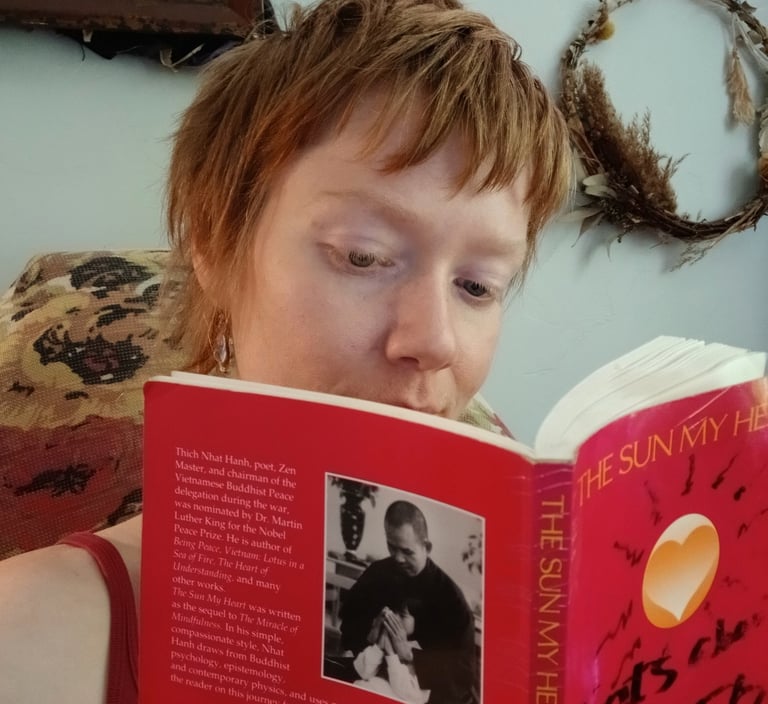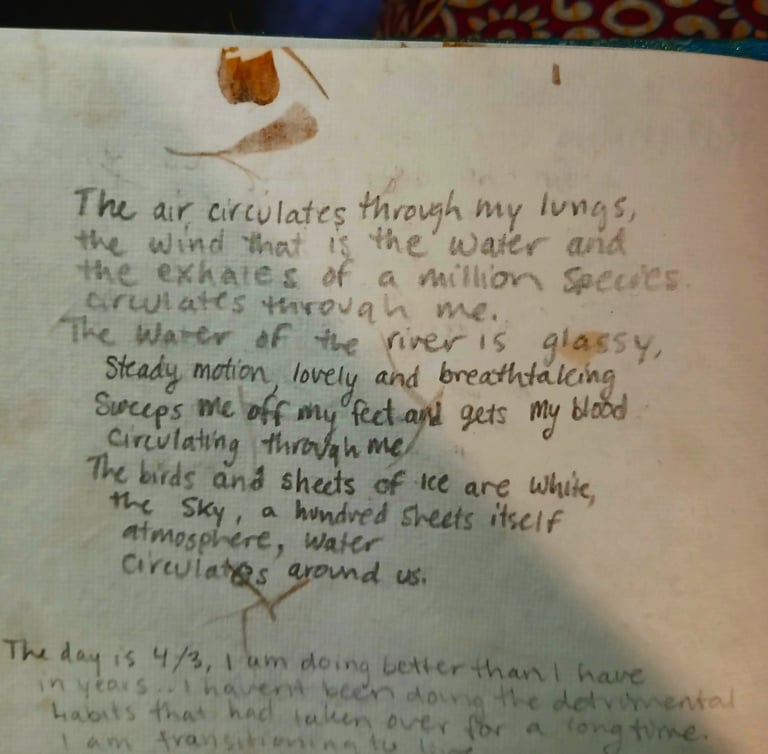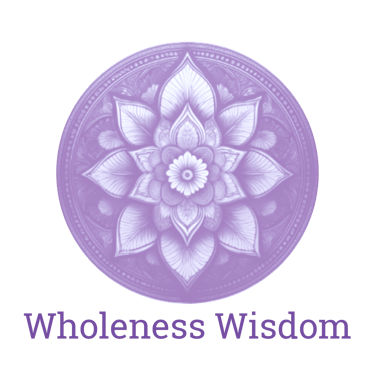Mindfulness For Dissociation and Recovery
Easy Ways To Incorporate Mindfulness Into Daily Life And Come Home To Your Body
9/19/20248 min read


I’d like to share about my ten+ years' experience of applying mindfulness into my daily life, specifically while struggling with binge eating and other types of eating disorders. Bringing mindfulness to food issues led to deeper and lasting freedom over time for me.
When I had my eating disorder I felt like a force was lurking over my shoulder that at any time could hijack me. It left me confused, full of shame, and physically in pain.
Countless hours were lost to secretly bingeing; stockpiling ‘healthy’ food and having strict rules against ‘unhealthy’ food; quickly buying large amounts of ‘forbidden’ foods in secret; throwing away these foods after a binge; even dousing food in poisonous chemicals so that I couldn’t retrieve it later! Hours at the gym, exercising instead of living, and not wanting to face the next meal, I felt possessed. I didn't have a connection to my feelings and I lived life outside of my body. I didn't know how to relate to other people, and I avoided social situations to avoid food and eating. I kept tight control over my impulses, but when I was alone it was the hardest. Then, about eleven years ago, something changed.
Enter: mindfulness.
At the height of my struggle, I came across a book called The Sun My Heart, by Thich Nat Hahn. I was living in a closet off a friend’s kitchen, in exchange for caring for her child.
Thich Nat Hanh is known as the “father of mindfulness” and was a major influence on Western practices of Buddhism. Peace activist, prolific author, poet and teacher, he introduced me to the peace that is available through mindfulness. His direct pointers in this book brought my eating disorder to a new dimension, to awareness.
I didn’t know how my problem would be helped by these ideas, but the truth is that mindfulness in daily living can greatly shift perspective and offer simple ways to connect to oneself in the midst of stress and chaos.
The practices I adopted were easy. Because my desire and fear centered around food, I started with food-related experiences. I included buying food, serving food, in between bites, and after the meal.
Here are some ways I used mindfulness to heal my eating disorder.
Wash the dishes with mindfulness. See the dishes. “With mindfulness” simply means: with knowing that I am! Thich Nat Hanh said “To my mind, the idea that doing the dishes is unpleasant can only occur when you aren’t doing them”.
Mindfulness for me began with the senses. Buttoning the jacket knowing-seeing-feeling ‘buttoning the jacket.’ The eyes are seeing while the mind is going, so bring attention to the seeing. See. Movement of attention is mindfulness. Attending life is mindfulness. Being in life, with life.
Living in a dissociated way, out of my body and somewhere else, really dulled my senses. Returning to embodiment with mindfulness is about noticing the sensory experience.
I learned this and invited it to happen whenever the thought occurred to do it, and invited a mindset of mindfulness throughout the day. To renew my commitment, I wrote a little bit about mindfulness each day. I wanted a habit of mindfulness. Perseverance is key! I recommend keeping some notes or a journal about how mindfulness is present in your daily life.
One month into starting daily mindfulness I expressed in poetry the change that was noticed.
2013
The only thing that had changed in my life up to this point was mindfulness. I was still sleeping in a closet in someone else's house. I was still struggling with my body and food. Incorporating mindfulness into my daily living was a way of coming back into the body. Even when things were hard, my commitment to mindfulness remained. Some years later I learned that it doesn’t have to be on/off with mindfulness. It can be present when the habit is happening, too.
Geneen Roth, in her book Breaking Free From Emotional Eating, says:
“Awareness and compulsion cannot possibly exist together in the same moment. When you turn on a light, it is no longer dark. No matter how emotional you are, no matter if you’ve been bingeing for thirty years or thirty minutes, as soon as you are aware you are bingeing it is no longer a binge.
…if compulsion is marked by the absence of self, awareness is marked by the steady, unobtrusive presence of self. And it is precisely this difference that changes the entire nature of emotional behavior. When you are watching what you are doing, you simply will not behave in the same way as when you are not watching (e.g., judging yourself, numbing yourself).”
Roth's words brought me to use mindfulness even when I was in a relapse of behaviors. Here’s what I did after I found that mindfulness can be brought to a binge!
When the powerful force came upon me, like a demon that was about to possess my body and mind, at the first thought of powerlessness I would turn my attention to the knowing of it.
I would think or say to myself “bingeing”. I would use all the focus possible to acknowledge what was happening, without judging it.
Bringing mindfulness to the behaviors that used to haunt me was scary at first. Numbing was the point. But because I was really wanting to not be numb and live my life, I was willing to try. Once I did, mindfulness changed the experience. This was not because I avoided the binge, but because I committed to myself to be mindful during the experience.
These episodes became less frequent over time. I did seek the help of a doctor, therapist, and a dietician’s advice. However, none of the healthcare professionals I sought told me about mindfulness. I wish they had.
Once I started going deeper with inner-work (CT and Wholeness) and had made mindfulness part of my daily life, I no longer needed a dietician, doctor, or therapist because those behaviors were no longer a problem and I was back in touch with my body and feelings.
With the help of Consciousness based therapies- like Wholeness Work or Core Transformation, I left behind years of numbing behaviors. I wish that I had found them earlier because it took me over ten years of applying mindfulness alone to get to the next level of change that finally removed the issue for me. Consciousness work is a deeper level of work that goes to the unconscious structure of issues, below the level of mind and senses- to the nervous system charge of what I now understand to be the ego-based nature of the problem.
Deeper methods of change can ensure these patterns’ underlying charges can be released. IFS, Psychoanalysis, and Therapy are expensive. NLP coaching can be an affordable support for a mindfulness-based recovery path.
Mindfulness is a great first step to full and lasting recovery, and it doesn't require an all or nothing mindset. Mindfulness is also free and private- another reason why it is a great first step to wellness. Fewer than half of all bulimics have ever sought treatment for their eating disorder and more than 10,800 people die per year as a result of all types of eating disorder, so taking small steps that lead to support down the line is not trivial. This is what I did.
If you’re struggling with binge eating, strict rules, compulsive eating, bulimia, or emotional food behavior, I do recommend mindfulness alongside a team to support you as you heal your relationship with food. In addition to medical support, practicing mindfulness can get you well on your way to a more peaceful relationship with yourself and food.






The air circulates through my lungs
The wind that is the water and
The exhales of a million species
Circulates through me.
The water of the river is glassy
Steady motion lovely and breathtaking
Sweeps me off my feet and gets my blood
Circulating through me
The birds and sheets of ice are white
The sky, a hundred sheets itself
Atmosphere, water
Circulates around us


“Where are you now, my good friend? Are you out in the field, in the forest, on the mountain, in a military camp, in a factory, at your desk, in a hospital, in prison? Regardless of where you are, let us breathe in and out together, and let the Sun of Awareness enter. Let us begin with this breath of awareness. Whether life is an illusion, a dream, or a wondrous reality depends on our insight and our mindfulness. Awakening is a miracle. The darkness in a totally dark room will disappear the moment the light is switched on. In the same way, life will reveal itself as a miraculous reality the second the Sun of Awareness begins to shine.”
The Sun My Heart
Thich Nat Hahn
1. Seeing
Turning my focus from thoughts, “(Just look away,” or “ You're horrible”), I would see as much of the process as possible. Noting it. When I was about to binge- to include mindfulness- I wouldn’t allow the TV or reading like I used to- I would eat with as little distraction as possible, seeing it. I’d binge with presence.
2. Tasting
People with EDs know that you don’t really taste the food during a binge, after the first bite- it’s just a blur. To bring mindfulness in, I would return during the binge to the taste.
Sometimes just tasting made the craze lose charge, sometimes not. Taste. ...... Taste.
3. Feeling
Texture would be noted. Sometimes I would instantly be less interested- once I really noticed the texture of the food. It felt abrasive or not enjoyable. The feeling of my bum in the chair, the feeling of the tool in hand to bring the food in (or using the food-as-tool- how that feels), or the feeling in my belly- or mouth.
4. Hearing
Because mindfulness during a binge takes away the extra sensory overload (tv, phone, book, music, radio), these situations became a lot quieter- but the noise of eating became more obvious. I would hear.
5. Writing
When I was having meals that weren't binges, a regular meal- I would make single line notes between bites. I would spend 20 minutes, a few times a week, eating a meal with a pen and paper
beside the plate.
I'd aim to set the fork down and make comments on direct observations. I was actively learning mindful eating.
"crunchy" or
"cinnamon and nutmeg overpowering"
This was a REALLY helpful super-charge to mindfulness in daily life.






Below I noted,
The day is 4/3, I am doing better than I have
in years… I haven’t been doing the detrimental
habits that had taken over for a long time.
I am transitioning to love.
